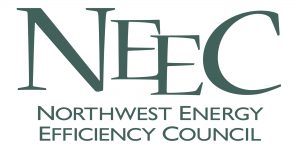Press Release from NEEC
Published Date: 1/27/2014
Innovation in Building Energy Efficiency Puts Seattle in National Leadership Spotlight
Making a big commercial building more energy efficient often happens in dribs and drabs. One year it may be a few lighting fixtures get replaced, the next year it may be more efficient office equipment. For Seattleites, the process is pretty routine. Building owners work with an energy service company to install a measure and then partner with Seattle City Light to apply for a rebate or financial incentive.
This traditional approach to energy efficiency is undergoing some new thinking at Seattle City Light in a three building pilot project now underway with customers.
Often it is difficult to see the effect on the energy bill of the newly installed pieces of equipment since the effects of weather and occupancy create large year to year variations in energy use. Estimates of the amount of saved energy are calculated based on engineering analysis. The amount of the utility’s financial incentive is based on this estimate of savings and is paid immediately upon the installation of the project measures – without really knowing how well those estimates pan out over time.
Pay for Performance (PfP) is an innovative pilot project from Seattle City Light designed to test a new way to calculate the utility financial incentive and to provide more surety that the project delivers energy savings year over year. PfP offers the chance for building owners to receive a greater incentive than what they get under the traditional system, if they can show more than predicted measured and verified savings at the meter. For Seattle City Light, it reduces the utility’s risk in actually receiving the savings for which they are paying.
“Rather than prescribing specific energy efficiency measures to install, Seattle City Light is giving these businesses an opportunity to demonstrate their abilities to increase the energy efficiency of their buildings using whichever approaches they choose,” City Light General Manager and CEO Jorge Carrasco said. “We hope that freedom combined with financial incentives based on performance will encourage innovative solutions that generate even greater energy savings.”
Three building owners, teaming with local energy service providers, won a competitive process sponsored by SCL to participate in this innovative PfP pilot program.
At 34 stories and more than 580,000 square feet, 1111 Third Avenue is an icon of the Seattle skyline. Talon Portfolio Services and Urban Renaissance have partnered with ATS Automation to be their energy services professional and manage the Seattle City Light Pay for Performance project. “The SCL Pay for Performance program allows me to invest in energy conservation and take the building through a transformative energy efficiency renovation as well,” said Bruce Hoffman, Urban Renaissance’s Chief Engineer. According to Pete Segall, ATS Energy Services Manager, “The Pay for Performance Program allows us to focus our engineering efforts on implementing efficiency measures instead of detailed calculated analyses. This opens the door for more efficiency opportunities, no matter how small, plus the proof is in the actual measured savings.”
WA Holdings One Union Square building was also selected by Seattle City Light as a participant in the PfP pilot incentive program. Rick Mock of WA Holdings says, “we are continually looking at innovative strategies to improve our building’s performance as well as the environment our tenants and staff work in every day. Working alongside our Energy Services partner McKinstry, we will be measuring and verifying on a monthly basis our progress against our annual goals for reducing the building’s overall electrical consumption.” Mock goes on to say, “The PfP pilot incentive program is unique in that we will benefit from all energy conservation strategies we employ – capital, operations & maintenance – not only in reduced annual utility expenses but also via ongoing utility incentives that are paid based on the buildings actual performance against a measured baseline, year over year.”
The third building in the pilot program is the Lake Union Building a seven story, 93,905 square foot commercial office building. Built in 1970, the Lake Union Building is an all-electric glass and concrete structure. MacDonald-Miller Facility Solutions is the energy services provider for this project. Perry England, Vice President of MacDonald-Miller says, “A pay for performance model provides an equitable distribution of risk among the utility, owner and service provider. Unlike most of today’s incentive programs, a pay-for-performance incentive program rewards the owner and their energy team for exceeding the stipulated savings expectations. In essence, it unlocks the true opportunity for mitigating the energy waste that exists in most buildings while providing a transparent measurement and verification process.”
The PfP pilot is designed to run for the next three years as both SCL and building owners evaluate this new approach. With an opportunity for both building owners and SCL to find advantages over the current approach, PfP could expand more broadly as a program option for Seattle City Light customers. Other utility and energy efficiency organizations around the country are watching the pilot closely to assess whether Seattle once again is leading in building energy efficiency innovation.
About the Northwest Energy Efficiency Council (NEEC)
The Northwest Energy Efficiency Council is a non-profit trade association of the energy efficiency industry. NEEC member companies provide energy efficiency products and services and assist in the development and implementation of energy efficiency programs. NEEC advocates an affordable, energy efficient future for commercial, industrial and residential customers.
Contacts:
Stan Price, NEEC 206-292-5592
Pete Segall, ATS 425-264-9335
Perry England, MacDonald-Miller 206-768-4218
Matt Wegworth, McKinstry 206-762-3311
Download a PDF of this release below.
